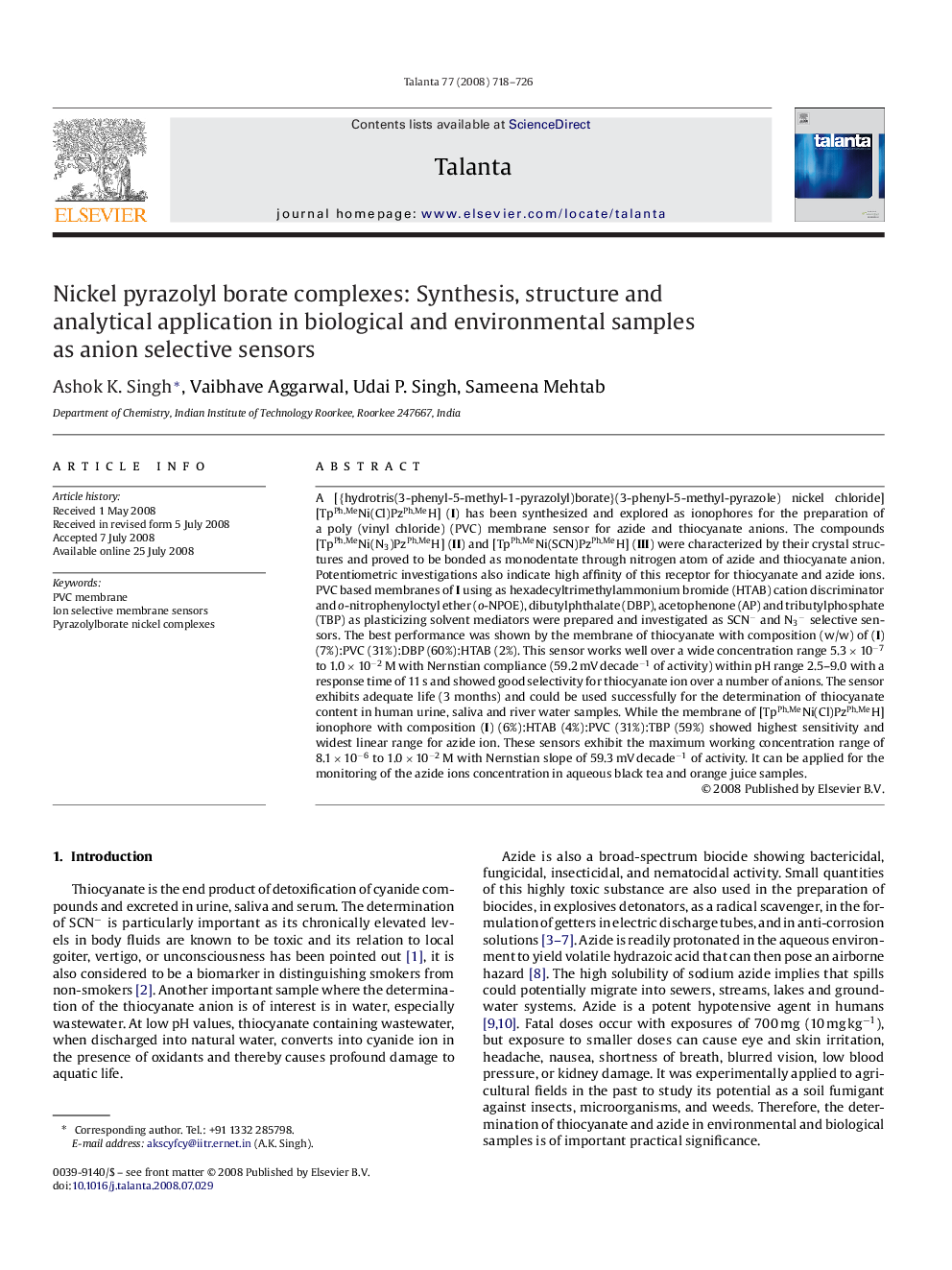| کد مقاله | کد نشریه | سال انتشار | مقاله انگلیسی | نسخه تمام متن |
|---|---|---|---|---|
| 1243126 | 969654 | 2008 | 9 صفحه PDF | دانلود رایگان |
عنوان انگلیسی مقاله ISI
Nickel pyrazolyl borate complexes: Synthesis, structure and analytical application in biological and environmental samples as anion selective sensors
دانلود مقاله + سفارش ترجمه
دانلود مقاله ISI انگلیسی
رایگان برای ایرانیان
کلمات کلیدی
موضوعات مرتبط
مهندسی و علوم پایه
شیمی
شیمی آنالیزی یا شیمی تجزیه
پیش نمایش صفحه اول مقاله

چکیده انگلیسی
A [{hydrotris(3-phenyl-5-methyl-1-pyrazolyl)borate}(3-phenyl-5-methyl-pyrazole) nickel chloride] [TpPh,MeNi(Cl)PzPh,MeH] (I) has been synthesized and explored as ionophores for the preparation of a poly (vinyl chloride) (PVC) membrane sensor for azide and thiocyanate anions. The compounds [TpPh,MeNi(N3)PzPh,MeH] (II) and [TpPh,MeNi(SCN)PzPh,MeH] (III) were characterized by their crystal structures and proved to be bonded as monodentate through nitrogen atom of azide and thiocyanate anion. Potentiometric investigations also indicate high affinity of this receptor for thiocyanate and azide ions. PVC based membranes of I using as hexadecyltrimethylammonium bromide (HTAB) cation discriminator and o-nitrophenyloctyl ether (o-NPOE), dibutylphthalate (DBP), acetophenone (AP) and tributylphosphate (TBP) as plasticizing solvent mediators were prepared and investigated as SCNâ and N3â selective sensors. The best performance was shown by the membrane of thiocyanate with composition (w/w) of (I) (7%):PVC (31%):DBP (60%):HTAB (2%). This sensor works well over a wide concentration range 5.3Â ÃÂ 10â7 to 1.0Â ÃÂ 10â2Â M with Nernstian compliance (59.2Â mVÂ decadeâ1 of activity) within pH range 2.5-9.0 with a response time of 11Â s and showed good selectivity for thiocyanate ion over a number of anions. The sensor exhibits adequate life (3 months) and could be used successfully for the determination of thiocyanate content in human urine, saliva and river water samples. While the membrane of [TpPh,MeNi(Cl)PzPh,MeH] ionophore with composition (I) (6%):HTAB (4%):PVC (31%):TBP (59%) showed highest sensitivity and widest linear range for azide ion. These sensors exhibit the maximum working concentration range of 8.1Â ÃÂ 10â6 to 1.0Â ÃÂ 10â2Â M with Nernstian slope of 59.3Â mVÂ decadeâ1 of activity. It can be applied for the monitoring of the azide ions concentration in aqueous black tea and orange juice samples.
ناشر
Database: Elsevier - ScienceDirect (ساینس دایرکت)
Journal: Talanta - Volume 77, Issue 2, 15 December 2008, Pages 718-726
Journal: Talanta - Volume 77, Issue 2, 15 December 2008, Pages 718-726
نویسندگان
Ashok K. Singh, Vaibhave Aggarwal, Udai P. Singh, Sameena Mehtab,